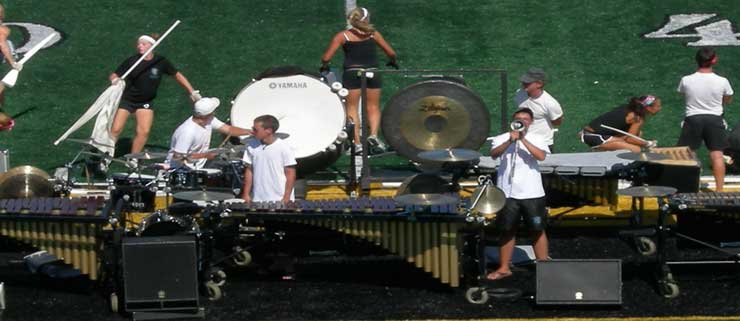 In my last article, I gave some general tips for selecting an appropriate jazz bass drum. In this article, I’ll suggest some considerations everyone should take when selecting the toms and snare drum. As stated previously, there are simply NO golden rules on this topic. However, there are some things every educator should consider when selecting jazz drums for their program.
In my last article, I gave some general tips for selecting an appropriate jazz bass drum. In this article, I’ll suggest some considerations everyone should take when selecting the toms and snare drum. As stated previously, there are simply NO golden rules on this topic. However, there are some things every educator should consider when selecting jazz drums for their program.
Last time, I discussed the fact that the bass drum size will determine the height of the rack toms (the toms above the bass drum). A large bass drum will require the rack toms to be very high for the smaller students. Similarly, the depth of the rack toms can cause the same problem. If your rack toms are 10 inches or larger in depth, it is likely that your smaller students will find it very hard to maneuver around the set, and this ultimately results in learning bad performance techniques.
The diameter of the toms is also very important. In my experience as a jazz drummer, I have found that toms which are 10 inches in diameter and smaller do not work well in many acoustic situations. By ‘acoustic situations’ I am referring to performances in which microphones are not used on the drumset. This is one of those topics that is very slippery. I am not suggesting that all 10 inch toms on the planet sound terrible in acoustic situations. However, in my experience playing in venues and clubs across the country, I have found that these smaller toms do not ‘speak’ very well in most rooms. This is especially true when speaking of big band performances. The only exceptions I’ve found involve rooms with hardwood floors and high ceilings. Studio based performing and recording with microphones are different situations completely. Small toms will work fine in most of these situations.
I also suggest avoiding large tom sizes associated with rock and other forms of popular music. For example, floor toms which are 15 inches in diameter and larger produce very low sounds. Using these larger floor toms will effect the balance and symmetry between all of the voices in your set. In other words, the bass drum occupies the lower end of all the voices. Therefore, there is no need for the floor tom to occupy that frequency as well.
Unlike the issue of rack tom depth, there is no need to worry about the height of the floor tom for your smaller students. Most of these toms will come with adjustable legs or stand mounts which will allow them to be easily adjusted to suit the needs of any size student.Taking all of these things into account, my general recommendation for selecting toms are as follows: (all sizes are diameter x depth)
Rack Tom: 12x8
Floor Tom: 14x14
If you will be purchasing a set which includes an additional rack tom, there are several options you may need to consider. As stated earlier, I would generally avoid purchasing a rack tom which is 10 inches in diameter or smaller. Instead, I would recommend selecting a tom that is either 11x8 or 13x8. Many brands and models have these sizes. However, occasionally these sizes are not available. If this is the case in your situation, I would suggest reverting back to the 10x8. I stand by my previous statement that these 10 inch toms rarely work well in acoustic situations. However, this can be considered as a ‘last resort’....and not such a bad one. If your budget does not allow you to purchase a model which includes the 11x8 or 13x8, don’t worry. You can always utilize the 10x8 in other performance situations, such as pep band, marching band (front ensemble), or concert percussion situations, including the symphony orchestra and/or wind symphony.This leaves the snare drum. Several of the issues we’ve discussed to this point do not apply to snare drum selection. For example, height with regard to student size is irrelevant here, since you can adjust the snare drum stand to basically any height. I generally recommend a snare drum that is 14 inches in diameter for ‘general purpose’ playing. This size will work well in essentially every musical situation conceivable. For this reason, you can’t go wrong with a 14 x 5.5 snare drum, which is the size that you will find with most sets at your local music store.
I hope this clears up any questions you may have regarding drum sizes. As always, feel free to This email address is being protected from spambots. You need JavaScript enabled to view it. if you have any additional questions. In my next article, I’ll suggest some tips for selecting appropriate cymbals and hardware for your jazz drumset.







 Scroll down to view the comparison chart of over a dozen different portable digital audio recorders.
Scroll down to view the comparison chart of over a dozen different portable digital audio recorders.